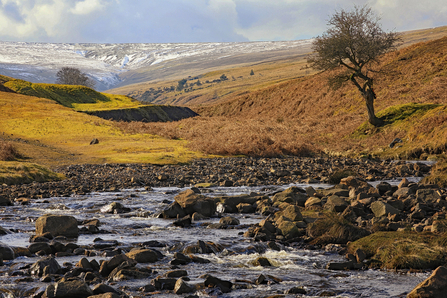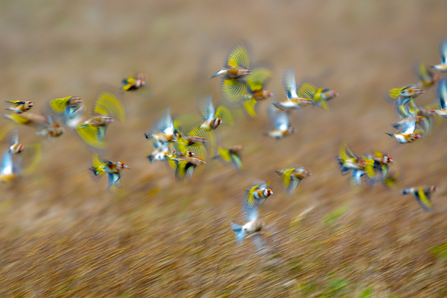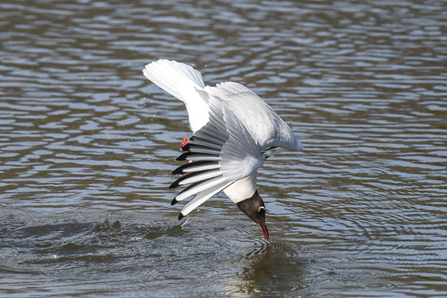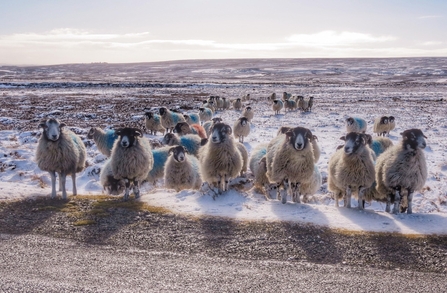The ‘Views of Weardale’ competition, organised by a project called Living Uplands which protects and promotes Upland moorland, aimed to find exceptional landscape and wildlife images from the Weardale area. More than 50 entries were received and were judged by a panel including Durham Wildlife Trust representatives and the team from the Living Uplands project. After careful consideration, winner and runner-up entries were chosen in each category.
Picture perfect prize winners
Winners
The winning landscape image was taken by Ian Turner and features a view of Bollibroke.
Ian said: “The use of a long lens (100mm – 400mm used at about 325mm) was deliberate as I wanted to get the beautiful snow-clad hills in the distance to look closer than they really were. The river and tree in the foreground gave extra interest to the composition.”

Bollibroke (c) Ian Turner
The winning wildlife image was taken by Hamish Paterson and was titled ‘Goldfinch scramble over set-aside land Thornley’.
Hamish said: “This image captures a charm of Goldfinch (Carduelis carduelis) lifting off a field planted with bird seed mix, including linseed, by a local Weardale farmer under the Stewardship Scheme. It was taken at relatively slow shutter speed (1/80 second) whilst panning with the flock to capture a deliberately blurred image of the wings to produce an abstract effect that reproduces the actual sensation of witnessing a charm. I like this image as it reflects the behaviour and habitat of the subject, and the sensation of watching these colourful birds.”

Birds in Flight Winner Wildlife (c) Hamish Paterson
The Living Uplands project is delighted with the quantity and quality of entries received and would like to thank all those who took the time submitting their photographs. The first prize for both categories in the competition will be a visit to the biggest black grouse Lek in the dales. Sadly, the movement restrictions due to coronavirus have resulted in this being delayed until the 2021 season. Living Uplands looks forward to welcoming the winners then. In the meantime, winners and runners-up have each received a canvas copy print of their winning image and we hope that this memento will take pride of place on their walls.
“With 37 nature reserves stretching from the Tees to the Tyne, we are well aware of just how many beautiful and varied landscapes we have in the area and what a vast array of exceptional wildlife is out there. It was fantastic to see some of this captured in the photographs submitted to the competition.”Durham Wildlife Trust
Runners-up:
Wildlife
Black-headed Gull by Gwynneth Heeley, who described capturing the image: “This image was taken from the West Hide at Low Barns Nature Reserve. This Black-headed Gull was part of a group of five who spent the morning squabbling over anything and everything. Eventually the others left and this gull spent a long time diving and fishing alone.”

Black-headed Gull (c) Gwynneth Heeley
Landscape
Pregnant Ewes crossing over the moors by Tracey Laing from Consett, County Durham. Tracey said: “I took the photograph out of my car window as when I stopped they all came towards me, I liked the picture as I thought it showed the harshness of winter in Weardale but also the beauty of it and that it would soon be spring and their lambs would soon be here.”

Pregnant Ewes crossing over the moors (c) Tracey Laing
Living Uplands
The Living Uplands project was first created in 2015 to focus the attention on one of the UK’s most endangered birds, the iconic Black grouse. While developing educational resources on this species it became obvious that its story lies within a wider, richer and massively diverse balance of nature and that there is a far bigger story to tell about the managed uplands of England. The project is looking at pieces of work ranging from the geology of upland areas, pollution and many wildlife and conservation schemes. Many of these projects demonstrate how, taken together, each has a profound impact on the balance of nature across the Living Uplands.
